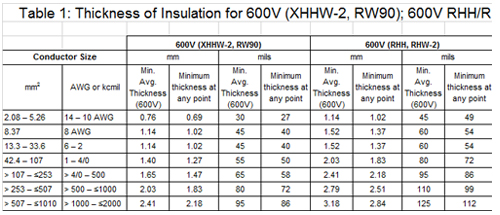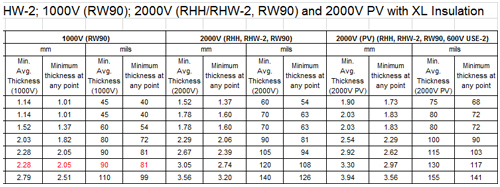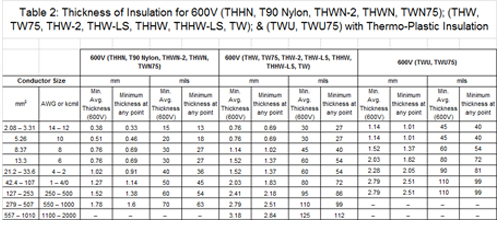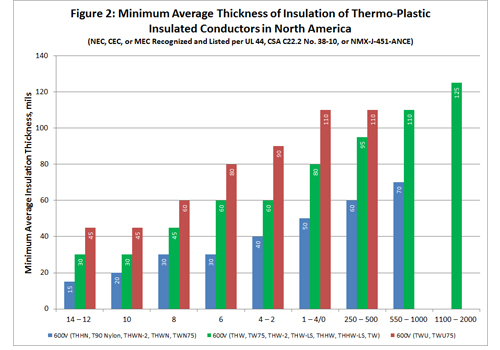National electrical codes provide the necessary recognition for products and stipulate the installation requirements for their applications to ensure safety of personnel and property. Product standards operationalize these national or regional recognitions and define additional requirements for the evaluation of products for Listing by the Nationally Recognized Testing Laboratories (NRTLs) and the ongoing monitoring of these Listings during manufacturing of the listed products to ensure their suitability for the intended uses. Harmonization of similar requirements is critical at regional levels to permit cross-border trade while maintaining respect for some local requirements. The paper discusses a myopic interpretation of increasing voltage rating for some 600 V rated products and their impact on Thermo-Plastic and Thermoset Insulated Wire and Cable Products.
Introduction
In North America, Canadian Electrical Code (CEC) – CSA C22.1, Mexico Electrical Code (MEC) – NOM 001, and National Electrical Code (NEC) – NFPA 70 provide requirements for electrical installations to help ensure safety of personnel and property. These codes also provide recognition for product types that could be used for specific applications. Along with such recognition, there are some performance and prescriptive requirements included in these codes for the recognized products to ensure that they meet those requirements.
The products standard generally developed and maintained by Standards Developing Organizations (SDOs) at a national level further define the product construction and performance requirements to facilitate their Listing. These standards also define requirements for ongoing monitoring of these products during manufacturing to ensure their compliance for the Listing. Canadian Standards Association (CSA), Asociación de Normalización y Certificación (ANCE), and Underwriters Laboratories (UL) are the prominent SDOs in North America involved in developing and maintaining product standards for products recognized in the aforementioned electrical codes.
The third and the final leg of safety is ensured when the local authority having jurisdiction (AHJ) performs the evaluation of the installation to confirm compliance with the requirements of the codes.
While the MEC is based on NEC, there are some differences between NEC/MEC vs. CEC. One such difference is in the low voltage ratings. Both NEC and MEC have 600 V and 2000 V. While CEC has 600 V and 1000 V. As it should be, the efforts are underway to include 1000 V in MEC and NEC, and 2000 V in CEC. These efforts require harmonizing product standards also. The requirements for 600 V, 1000 V, and 2000 V rated wire and cable products is creating a need to understand the complexities and then adopt and implement requirements that can help maintain the level of performance that has been established through experience and past decisions.
Experience and Situation
Council for Harmonization of Electrotechnical Standards of the Nations in the Americas (CANENA) became a reality in 1992 after the passage of North American Free Trade Agreement (NAFTA). First efforts to harmonize wire and cable standards between Canada, Mexico, and the US began in 1996.
Table 1 and Figure 1 provide some dimensional details about the 600 V, 1000 V, and 2000 V Thermoset Insulated products recognized in CEC, MEC or NEC and Listed in accordance with CSA, ANCE or UL standards.

Table 1, Part 1

Table 1, Part 2

Figure 1
Similarly, Table 2 and Figure 2 provide some dimensional details about the 600 V Thermo-Plastic Insulated products recognized in CEC, MEC or NEC and Listed in accordance with CSA, ANCE or UL standards.
In the current ongoing efforts, it is being proposed that once the existing 600 V conductors with thermo-plastic or thermoset insulations meet the Long-Term Insulation Resistance (LTIR) test requirements at their rated temperatures while subjected to a-c voltage equal to the voltage rating of the wire (ex. 1000 V for THHN/THWN-2 or XHHW-2) be permitted to be rated at that new voltage.

Table 2

Figure 2
While such prerequisite is necessary, it is not a sufficient condition to change the rating of the existing 600 V rated conductors to 1000 V or 2000 V.
Discussion
A cursory look at Table 1 or Figure 1 shows that the insulation thickness is different for 600 V vs. 1000 V vs. 2000 V vs. PV (2000 V) products. The insulation type, XL (cross-linked), shown in this table and figure is the same for all products to make this point. Interestingly enough, 600V rated Type XHHW-2 and RHH/RHW-2 conductors with XL insulation could be used in an identical installation. Yet, there is a different insulation thickness requirement. The primary reason is that RHH/RHW-2 products come from the reference to rubber insulation used for these products in their early days, which required significantly thicker insulation to overcome their softer mechanical properties. Thus, when XL insulation became a reality for RHH/RHW-2, the thickness was reduced. However, XL could provide much more robustness than rubber and to take advantage of those properties, a new category – XHHW (or, XHHW-2) – was created. It should be noted that there is a significant difference in the insulation thickness between 600 V rated RHH/RHW-2 and 2000 V rated RHH/RHW-2. Further, for PV (2000 V), there is an additional insulation thickness requirement to ensure safe installation in photovoltaic installations.
RW90 conductors were rated 1000 V in CEC. To support harmonization, CEC decided to include 600 V and 2000 V ratings for such conductors. The common product requirements were then harmonized with ANCE and UL. There is still more work to be done to achieve complete harmonization where by 600 V rated RW90 in Canada = XHHW-2 in Mexico = XHHW-2 in the US and all the evaluation requirements are the same.
Review of Table 2 and Figure 2 confirms one reality quickly – absence of 1000 V and 2000 V ratings. Thermo-plastic insulation material (mostly PVC) hasn’t been evaluated for these voltage ratings and other requirements of various applications. Thus, it would be a myopic inference that THHN/THWN-2 conductors are suitable for 1000 V rating solely on the basis of their compliance to LTIR test in a 90 C water bath at 1000 V.
In the absence of clearly defined criterion for Listing, thickness appears to be a reasonable proxy for additional mechanical and physical properties for the materials to ensure products’ suitability for various applications that could be envisioned by those involved in the development and implementation of codes and standards.
An example of equivalent performance could be:
Breaking load for an 80 mil thick insulation over 0.250” diameter conductor with 2000 psi tensile strength insulating material can be computed to be 165.9 lb.
Tensile strength required for a 45 mil thick insulation over 0.250” diameter conductor withstanding same breaking load is 3977 psi. Thus, an insulating material with 1800 psi strength would have to be modified to have the new tensile strength of 3977 psi to deliver an equivalent performance to that of an 80 mil thick insulation. Further, this new fortified material would have to meet all other Listing requirements, including LTIR at 90°C at 1000 V!
Another consideration to note is that most 600V rated conductors today are used at 120, 240, 277, and in a few cases at 480 Volts. A 1000 V rating is not needed for these applications. Changing their rating to 1000 V rating will permit these conductors to be utilized in installation where no other hazards have been assessed. Simply relying on meeting 1000 V LTIR (at 90° C for 90° rated insulations) is not a complete assessment. Today, it is possible to use same XL material to manufacture “600 V rated RW90/XHHW-2”, “1000 V rated RW90”, “2000 V rated RHH/RHW-2”, and “2000 V rated PV (identified as “2000 V RHH/RHW-2 600 V USE-2”). The cold impact force or crushing force withstand by these four conductors will be progressively higher as the insulation thickness on them is progressively higher. Thus, there is at least some reference through 1000 V RW90 performance, one can establish performance requirements for 1000 V rated XHHW-2/RW90. There is no such benchmark in case of thermos-plastic insulated conductors in Table 310-104(A) of the NEC.
Table 310-104(B) of the NEC also provides another reference where by two different types of thermoset materials have different physical properties for 2000 V rated products. This difference is highlighted by the thicknesses required for the same size of the conductor.
Conclusions and Recommendations
The journey, which began in the 1990s, to harmonize codes and standards in North America shall continue as the regression to different requirements for products that are very similar, if not identical, is not productive for all involved.
Experience in the industry shall be utilized to clarify and define requirements that promote uniform interpretations and implementations of the requirements.
Opportunities to include performance requirements in lieu of prescriptive requirements should be encouraged to permit innovations in the products. All manufacturers need not have to provide XHHW-2 or THHN/THWN-2 with the same insulation thickness. While the present day codes and standards are far from such reality, a possibility exists to make the case. Until then, prudence shall govern and prescriptive requirements should be used as needed to ensure safety of personnel and property.
1 -2 ratings signify 900 C Wet rating for the insulation.
2 A side note: This was the intent for the effort that was made in 1990s in the NEC code panels. However, the process wasn’t ready at that time for “Performance Based” requirements in the NEC.










Find Us on Socials